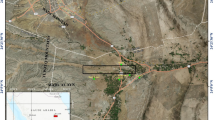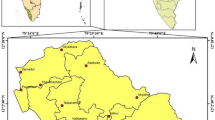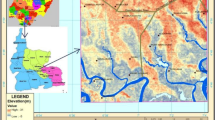Abstract
The El Moghra area is located in northwestern Egypt in the Western Desert. It is classified as the first priority of the national project to reclaim 1.50 million feddan of Egypt’s desert lands. Groundwater quality assessment of the El Moghra aquifer is essential because irrigation water requirements in the El Moghra area depend solely on groundwater. A geochemistry analysis was conducted for 230,000 feddans from forty-six groundwater samples collected during the drilling process of deep wells in year 2018 and 2019. Our study’s main objective is to determine whether the groundwater in the El Moghra aquifer is suitable for irrigation use. ArcGIS was used to prepare the geospatial distribution maps of major elements. Hydrochemical characteristics and groundwater types were identified from descriptive analyses of groundwater samples. Multivariate statistical analysis was run using SPSS; correlation coefficients were first determined; then, a correlation matrix was generated. Principal component analysis was performed and a covariance matrix with varimax rotation was produced. Results revealed the alkalinity and the high salinity of groundwater in the project study area. Most of the samples had a total hardness greater than 300 mg/l. Sodium chloride (Na–Cl) is the dominant type for groundwater samples. The mechanism controlling groundwater chemistry depends on rock weathering. Principal component analysis results showed that two eigenvectors among ten have a 72.86% contribution to the cumulative variance. The higher TDS values (14,008 mg/l) confirm the ions release when the upward groundwater flow from the lower Nubian Sandstone aquifer system to the upper quaternary aquifer occurs. Additionally, the geospatial maps of ion distribution showed that the frequent release of minerals happens in the northwestern part of the project study area: the eastern Qattara Depression. A perfect correlation between sodium and chloride distributions was obtained, and it is identical to the electrical conductivity distribution as well. Our study recommends very salt-tolerant crops as canola, barley, quinoa, and jojoba to be planted in the project area. Drought-tolerant crops as Barbary fig and Jatropha are also recommended. Applying irrigation water frequently with short intervals between irrigations to avoid soil drying and surface clusters’ formation, as well as enhance leeching of salts away from the root systems, is essential.









Similar content being viewed by others
References
Abbasi, T., & Abbasi, S. A. (2012). Water quality indices. (p. 384). Elsevier.
Abbas, Z., Mapoma, H. W. T., Su, C., Aziz, S. Z., Ma, Y., & Abbas, N. (2018). Spatial analysis of groundwater suitability for drinking and irrigation in Lahore, Pakistan. Environmental Monitoring and Assessment, 190, 391. https://doi.org/10.1007/s10661-018-6775-3
Abdel Baki, A. A. (1983). Hydrogeological and hydrogeochemical studies on the area west of Rosetta branch and south El Naser canal. PhD Thesis, Faculty of Science, Ain Shams University, Cairo, Egypt, p 156.
Abdel Mogith, S. M., Ibrahim, S. M. M., & Hafiez, R. A. (2012). Groundwater potentials and characteristics of El-Moghra aquifer in the vicinity of Qattara Depression. Egyptian Journal of Desert Research, 63(1), 1–20. https://doi.org/10.21608/EJDR.2013.5821
Ahmed, S. (2006). Application of Geostatistics in Hydrosciences. In M. Thangarajan (Ed.), Groundwater resource evaluation, augmentation, contamination, restoration, modeling, and management. (pp. 78–111). Capital Publishing Company.
Alcala, F. J., & Custodio, E. (2008). Using the Cl/Br ratio as a tracer to identify the origin of salinity in aquifers in Spain and Portugal. Journal of Hydrology, 359(1–2), 189–207. https://doi.org/10.1016/j.jhydrol.2008.06.028
Alley, W. M. (1993). Regional ground-water quality. (p. 634). Wiley.
APHA. (1998). American Public Health Association, Standard methods for the examination of water and wastewater, 20th ed. In: Clesceri L.S., Greenberg A.E., Eaton A.D., APHA (Eds.) Washington, DC.
ASCE. (2000). Task Committee Artificial neural networks in hydrology I: Preliminary concepts. Journal of Hydrologic Engineering ASCE, 5(2), 115–123. https://doi.org/10.1061/(ASCE)1084-0699(2000)5:2(115)
Ayers, R. S., & Westcot, D. W. (1985). Water quality for agriculture; M-56-ISBN 92-5-102263-1. Rome, Italy.
Belal, A. B., Mohamed, E. S., Saleh, A., Jalhoum, M. E., Hendawy, E. A., Abdou, M., Sayed, M. E. (2018). Optimum cropping pattern assessment of El-Moghra area, Egypt using remote sensing and GIS techniques. 13th International Conference of Egyptian Soil Science Society (ESSS) "Management of Water and Soil Resources under Global Climate Changes" Cairo, Egypt.
Belkhiri, L., & Mouni, L. (2012). Hydrochemical analysis and evaluation of groundwater quality in El Eulma area, Algeria. Applied Water Science, 2, 127–133. https://doi.org/10.1007/s13201-012-0033-6
Bian, J., Nie, S., Wang, R., Wan, H., & Liu, C. (2018). Hydrochemical characteristics and quality assessment of groundwater for irrigation use in central and eastern Songnen Plain, Northeast China. Environmental Monitoring and Assessment, 190, 382. https://doi.org/10.1007/s10661-018-6774-4
Busico, G., Kazakis, N., Cuoco, E., Colombani, N., Tedesco, D., Voudouris, K., & Mastrocicco, M. (2020). A novel hybrid method of specific vulnerability to anthropogenic pollution using multivariate statistical and regression analyses. Water Research, 171(15), 115386. https://doi.org/10.1016/j.watres.2019.115386
Collins, W. D. (1923). Graphic representation of water analyses. Industrial and Engineering Chemistry, 15(4), 394.
CropWat. http://www.fao.org/land-water/databases-and-software/cropwat/en/. accessed on 1/6/2020
Dawoud, M. A., Darwish, M. M., & El-Kady, M. M. (2005). GIS-based groundwater management model for western Nile Delta. Water Resources Management, 19, 585–604. https://doi.org/10.1007/s11269-005-5603-z
Deutsch, W. J. (1997). Groundwater geochemistry: Fundamentals and applications to contamination. (p. 221). CRC Press LLC.
Dillon, R., & Goldstein, M. (1984). multivariate analyses: Methods and applications. Wiley.
Dixon, B. (2005a). Groundwater vulnerability mapping: A GIS and fuzzy rule based integrated tool. Applied Geography, 25(4), 327–347. https://doi.org/10.1016/j.apgeog.2005.07.002
Dixon, B. (2005b). Applicability of neuro-fuzzy techniques in predicting groundwater vulnerability: A GIS-based sensitivity analysis. Journal of Hydrology, 309(1–4), 17–38. https://doi.org/10.1016/j.jhydrol.2004.11.010
Egyptian Countryside Development Company. https://elreefelmasry.com/land/1. accessed on 1/6/2020
Eheart, J. W., Cieniawski, S. E., Ranjithan, S. (1993). Genetic-algorithm based design of groundwater quality monitoring system. WRC Research Report No. 218, Water Resources Center, University of Illinois at Urbana-Champaign, 205 North Mathews. Avenue Urbana Illinois 61801, p 50.
El Alfy, M., Alharbi, T., & Mansour, B. (2018). Integrating geochemical investigations and geospatial assessment to understand the evolutionary process of hydrochemistry and groundwater quality in arid areas. Environmental Monitoring and Assessment, 190, 277. https://doi.org/10.1007/s10661-018-6640-4
El Kady, M. M., & Essa, E. F. (2018). Classification and land capability of some soils at El-Moghra Depression, Egypt. Egyptian Journal of Desert Research, 68(2), 243–258. https://doi.org/10.21608/EJDR.2019.7065.1019
El Maghraby, M. M. S. (2014). Geochemical and isotopic evidence of seawater intrusion into the Shallow Pleistocene Coastal Aquifer, West Alexandria, Egypt. Life Science Journal, 11(7), 749–762.
El-Tahlawi, M. R., Farrag, A. A., Ahmed, S. S. (2008). Groundwater of Egypt: "An environmental overview" Environmental Geology, 55, 639–652. https://doi.org/10.1007/s00254-007-1014-1
El-Toukhy, M., Charmy, H., Studer, M. (1997). Structural evaluation of the Eastern Part of the Western Desert and its implications for hydrocarbon, in: 14th Petroleum Exploration and Production Conference (EGPC), Cairo, pp. 156–177.
Eltarabily, M. G., Negm, A. M. (2018a). Groundwater management for sustainable development plans for the Western Nile Delta. In: Negm A. (eds) Groundwater in the Nile Delta. The Handbook of Environmental Chemistry, vol 73. Springer, Cham. https://doi.org/10.1007/698_2018_247
Eltarabily, M. G., Negm, A. M., Yoshimura, C., Abdel-Fattah, S., & Saavedra, O. C. (2018b). Quality assessment of southeast Nile Delta groundwater for irrigation. Water Resources, 45(6), 975–991. https://doi.org/10.1134/S0097807818060118
Eltarabily, M. G., Negm, A. M., Yoshimura, C., & Takemura, J. (2018). Groundwater modeling in agricultural watershed under different recharge and discharge scenarios for quaternary aquifer eastern Nile Delta, Egypt. Environmental Modeling and Assessment, 23, 289–308. https://doi.org/10.1007/s10666-017-9577-z
Freez, R. A., & Cherry, J. A. (1979). Groundwater. Prentice Hall Inc.
Fienen, M. N., Arshad, M. (2016). The international scale of the groundwater issue. In: Integrated Groundwater Management. Springer, Cham. https://doi.org/10.1007/978-3-319-23576-9_2
GAIN, Global Agricultural Information Network. (2016). Egyptian Land Reclamation Efforts. (FAS) Foreign Agricultural Service Office of Agricultural Affairs–Cairo–Egypt, (USDA) United States Department of Agriculture. https://www.fas.usda.gov/data/egypt-egyptian-land-reclamation-efforts
Gibbs, R. J. (1970). Mechanisms controlling world water chemistry. Science, 17(3962), 1088–1090. https://doi.org/10.1126/science.170.3962.1088
Giggenbach, W. F. (1988). Geothermal solute equilibria. Derivation of Na-K-Mg-Ca geoindicators. Geochimica Cosmochimica Acta, 52(12), 2749–2765. https://doi.org/10.1016/0016-7037(88)90143-3
Goodchild, M. F., Parks, B. O., & Steyaert, L. T. (Eds.). (1993). Environmental modeling with GIS. Oxford University Press.
Gu, X., Xiao, Y., Yin, S., Pan, X., Niu, Y., Shao, J., Cui, Y., Zhang, Q., & Hao, Q. (2017). Natural and anthropogenic factors affecting the shallow groundwater quality in a typical irrigation area with reclaimed water, North China Plain. Environmental Monitoring and Assessment, 189, 514. https://doi.org/10.1007/s10661-017-6229-3
Jeevanandam, M., Kannan, R., Srinivasalu, S., & Rammohan, V. (2007). Hydrogeochemistry and groundwater quality assessment of lower part of the Ponnaiyar River Basin, Cuddalore district, South India. Environmental Monitoring and Assessment, 132, 263–274. https://doi.org/10.1007/s10661-006-9532-y
Jianhua, S., Qi, F., Xiaohu, W., Yonghong, S., Haiyang, X., & Zongqiang, C. (2009). Major ion chemistry of groundwater in the extreme arid region northwest China. Environmental Geology, 57, 1079–1087. https://doi.org/10.1007/s00254-008-1394-x
Jha, M. K., Shekhar, A., & Jenifer, M. A. (2020). Assessing groundwater quality for drinking water supply using hybrid fuzzy-GIS-based water quality index. Water Research, 179, 115867. https://doi.org/10.1016/j.watres.2020.115867
Karanth, K. R. (1987). Ground water assessment: Development and management. (p. 720). Tata McGraw-Hill Publishing Company Limited.
Kerry, R., & Oliver, M. A. (2007). Determining the effect of asymmetric data on the variogram. I. Underlying asymmetry. Computers & Geosciences, 33(10), 1212–1232. https://doi.org/10.1016/j.cageo.2007.05.008
Khan, D. S., Fathy, M. S., & Abdelazeem, M. (2014). Remote sensing and geophysical investigations of Moghra Lake in the Qattara Depression, Western Desert, Egypt. Geomorphology, 207, 10–22. https://doi.org/10.1016/j.geomorph.2013.10.023
Khan, Q., Kalbus, E., Alshamsi, D. M., Mohamed, M. M., & Liaqat, M. U. (2019). Hydrochemical analysis of groundwater in Remah and Al Khatim regions, United Arab Emirates. Hydrology, 6(3), 60. https://doi.org/10.3390/hydrology6030060
Kurumbein, W. C., & Graybill, F. A. (1965). An introduction to statistical models in geology. McGraw-Hill.
Langelier, W. F., & Ludwig, H. F. (1942). Graphical methods for indicating the mineral character of natural waters. Journal of American Water Association, 34(3), 335–352. https://doi.org/10.1002/j.1551-8833.1942.tb19682.x
Liu, C. W., Lin, K. H., & Kuo, Y. M. (2003). Application of factor analysis in the assessment of groundwater quality in a Blackfoot disease area in Taiwan. Science of the Total Environment, 313(1–3), 77–89. https://doi.org/10.1016/S0048-9697(02)00683-6
Liu, J., Gao, Z., Wang, Z., Xu, X., Su, Q., Wang, S., Qu, W., & Xing, T. (2020). Hydrogeochemical processes and suitability assessment of groundwater in the Jiaodong Peninsula, China. Environmental Monitoring and Assessment, 192, 384. https://doi.org/10.1007/s10661-020-08356-5
Lo, C. P., & Yeung, A. K. W. (2003). Concepts and techniques of geographic information systems. (p. 492). Ltd., New Delhi.
Loucks, D. P., Van Beek, E. (2017). Water resources planning and management: An overview. In: Water Resource Systems Planning and Management. Springer, Cham. https://doi.org/10.1007/978-3-319-44234-1_1
Machiwal, D., Cloutier, V., Güler, C., Kazakis, N. (2018). A review of GIS-integrated statistical techniques for groundwater quality evaluation and protection. Environmental Earth Sciences, 77 (19). https://doi.org/10.1007/s12665-018-7872-x
Machiwal, D., Jha, M. K. (2012). Hydrologic time series analysis: Theory and practice. Springer, the Netherlands and Capital Publishing Company, New Delhi, p 303.
Machiwal, D., Jha, M. K. (2015). Identifying sources of groundwater contamination in a hard-rock aquifer system using multivariate statistical analyses and GIS-based geostatistical modeling techniques. Journal of Hydrology: Regional Studies, 4(A), 80–110. https://doi.org/10.1016/j.ejrh.2014.11.005
Mendoza, G. A., & Martins, H. (2006). Multi-criteria decision analysis in natural resource management: A critical review of methods and new modelling paradigms. Forest Ecology and Management, 230(1–3), 1–22. https://doi.org/10.1016/j.foreco.2006.03.023
Mohamaden, M. I. I., Hamouda, A. Z., & Mansour, S. (2016). Application of electrical resistivity method for groundwater exploration at the Moghra area, Western Desert, Egypt. The Egyptian Journal of Aquatic Research, 42(3), 261–268. https://doi.org/10.1016/j.ejar.2016.06.002
Monthly weather forecast and climate, El Dabaa, Egypt. https://www.weather-atlas.com/en/egypt/el-dabaa-climate#temperature. accessed on 1/6/2020
Narany, T. S., Ramli, M. F., Aris, A. Z., Sulaiman, W. N. A., Juahir, H., & Fakharian, K. (2014). Identification of the hydrogeochemical processes in groundwater using classic integrated geochemical methods and geostatistical techniques, in Amol-Babol Plain, Iran. Scientific World Journal, 2014, 419058. https://doi.org/10.1155/2014/419058
Ntanganedzeni, B., Elumalai, V., & Rajmohan, N. (2018). Coastal aquifer contamination and geochemical processes evaluation in Tugela Catchment, South Africa—Geochemical and Statistical Approaches. Water, 10(6), 687. https://doi.org/10.3390/w10060687
Park, S.-C., Yun, S.-T., Chae, G.-T., Yoo, I.-S., Shin, K.-S., Heo, C.-H., & Lee, S.-K. (2005). Regional hydrochemical study on salinization of coastal aquifers, western coastal area of South Korea. Journal of Hydrology, 313(3–4), 182–194. https://doi.org/10.1016/j.jhydrol.2005.03.001
Piper, A. M. (1944). A graphic procedure in geochemical interpretation of water analyses. Eos, Transaction American Geophysical Union, 25(6), 914–928. https://doi.org/10.1029/TR025i006p00914
Richards, L. A. (1954). Diagnosis and improvement of saline and alkali soils; US Department of Agriculture: Washington. (p. 60). DC.
Rufino, F., Busico, G., Cuoco, E., Darrah, T. H., & Tedesco, D. (2019). Evaluating the suitability of urban groundwater resources for drinking water and irrigation purposes: An integrated approach in the agro-Aversano area of southern Italy. Environmental Monitoring and Assessment, 191(12), 768. https://doi.org/10.1007/s10661-019-7978-y
Sayed, E., Riad, P., Elbeih, S., Hagras, M., & Hassan, A. A. (2019). Multi-criteria analysis for groundwater management using solar energy in Moghra Oasis, Egypt. The Egyptian Journal of Remote Sensing and Space Sciences, 22, 227–235. https://doi.org/10.1016/j.ejrs.2019.04.001
Sawyer, C. N., & McCarty, P. L. (1967). Chemistry of sanitary engineers. McGraw Hill.
Schoeller, H. (1955). Geochimie des eaux souterraines. Rev de l’Inst Francais du Petrole Paris, 10(3), 181–213.
Selvakumar, S., Chandrasekar, N., & Kumar, G. (2017). Hydrogeochemical characteristics and groundwater contamination in the rapid urban development areas of Coimbatore, India. Water Resources and Industry, 17, 26–33. https://doi.org/10.1016/j.wri.2017.02.002
Stiff, H. A., Jr. (1951). The interpretation of chemical water analysis by means of patterns. Journal of Petroleum Technology, 3(10), 15–17. https://doi.org/10.2118/951376-G
Templ, M., Filzmoser, P., & Reimann, C. (2008). Cluster analysis applied to regional geochemical data: Problems and possibilities. Applied Geochemistry, 23, 2198–2213. https://doi.org/10.1016/j.apgeochem.2008.03.004
Tennant, C. B., & White, M. L. (1959). Study of the distribution of some geochemical data. Economic Geology, 54(7), 1281–1290. https://doi.org/10.2113/gsecongeo.54.7.1281
USEPA. (1998). Guidance for Data quality assessment: Practical methods for data analysis. Quality Assurance Division, EPA QA/G-9, version QA97, United States Environmental Protection Agency (USEPA), Washington, DC.
USSL. (1954). Diagnosis and improvement of saline and alkaline soils. United States Salinity Laboratory (USSL). In L. A. Richards (Ed.), Handbook 60. (p. 159). United States Department of Agriculture (USDA), Washington DC.
Wells, C. M., & Price, J. S. (2015). A hydrologic assessment of a saline-spring fen in the Athabasca oil sands region, Alberta, Canada – a potential analogue for oil sands reclamation. Hydrological Processes, 29(20), 4533–4548. https://doi.org/10.1002/hyp.10518
Wilcox, L. V. (1955). Classification and use of irrigation waters 19; USDA Circular No. 969; Department of Agriculture: Washington, DC, USA.
WHO. (1989). Health guidelines for use of wastewater in agriculture and aquaculture. WHO Technical Report Series no.778. World Health Organization. Geneva.
Yadav, K. K., Gupta, N., Kumar, V., Choudhary, P., & Khan, S. A. (2018). GIS-based evaluation of groundwater geochemistry and statistical determination of the fate of contaminants in shallow aquifers from different functional areas of Agra city, India: Levels and spatial distributions. Royal Society of Chemistry Advances, 8(29), 15876–15889. https://doi.org/10.1039/C8RA00577J
Yates, S. R., & Warrick, A. W. (1987). Estimating soil water content using Cokriging. Soil Science Society of American Journal, 51(1), 23–30. https://doi.org/10.2136/sssaj1987.03615995005100010005x
Zaporozec, A. (1972). Graphical interpretation of water-quality data. Ground Water, 10(2), 32–43. https://doi.org/10.1111/j.1745-6584.1972.tb02912.x
Acknowledgements
The authors are grateful to the staff of the research center for their efforts in analyzing the groundwater samples. Authors also would like to thank the journal editor and the anonymous reviewers for their constructive comments. Thanks to Brady Holder (Kearney Agricultural Research and Extension center, UCANR, CA, USA) and Sommer Abdel-Fattah (McMaster University, Hamilton, ON, Canada) for proofreading the article.
Author information
Authors and Affiliations
Corresponding author
Ethics declarations
Conflict of interest
The authors declare no competing interests.
Additional information
Publisher's Note
Springer Nature remains neutral with regard to jurisdictional claims in published maps and institutional affiliations.
Rights and permissions
About this article
Cite this article
Eltarabily, M.G., Moghazy, H.E.M. GIS-based evaluation and statistical determination of groundwater geochemistry for potential irrigation use in El Moghra, Egypt. Environ Monit Assess 193, 306 (2021). https://doi.org/10.1007/s10661-021-09058-2
Received:
Accepted:
Published:
DOI: https://doi.org/10.1007/s10661-021-09058-2




